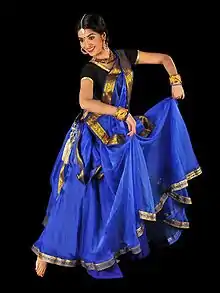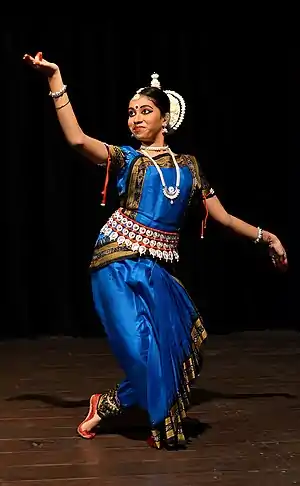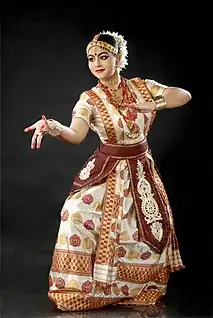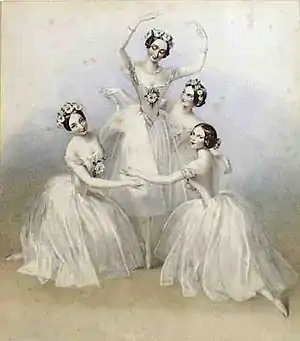
The important place of women in dance can be traced back to the origins of civilization. Cave paintings, Egyptian frescos, Indian statuettes, ancient Greek and Roman art and records of court traditions in China and Japan all testify to the important role women played in ritual and religious dancing from the start. In the Middle Ages, what has become known as ballet had its beginnings in Italian court festivals when women frequently played the parts of men. It was however in late 17th-century France that the Paris Opera produced the first celebrated ballerinas. While women began to dominate the ballet scene in the 18th century, it was with the advent of Romantic ballet in the 19th century that they became the undisputed centre of attraction with stars playing the leading roles in the works of Marius Petipa, appearing in theatres across Europe from Milan's La Scala to the Mariinsky Theatre in Saint Petersburg. More recently, women have played a leading role in developing various forms of modern dance including flamenco and expressionist dance.
History
Women have always played a predominant role in dance, as can be seen from its earliest history until the emergence of formal dances in the 15th century which developed into ballet.
Antiquity
Cave paintings from as long ago as 6000 BC provide scenes of dancing women. Examples can be seen in the Addauta Cave near Palermo and in the Roca dels Moros in Catalonia. In Ancient Egypt, women performed ritual dances for religious ceremonies such as funerals, as illustrated by frescos on the pharaohs' tombs.[1] The oldest records of organised dance and of professional female dancers come from Egypt. Especially in the Old Kingdom, women were organised into groups known as khener, apparently being joined by men only at a later stage.[2]
In the Indian subcontinent too, there is early evidence of dancing women, most notably a bronze statuette from Mohenjo-daro in the Indus Valley dating from around 2500 BC.[3][4] While men's early participation in dancing rituals appears to have been connected to hunting and fighting, women's dance was above all related to fertility, both agricultural and human.[5]
 Dancing women, El Cogul caves, Lérida
Dancing women, El Cogul caves, Lérida Dancing girl statuette from Mohenjo-daro, 2500-1500 BC
Dancing girl statuette from Mohenjo-daro, 2500-1500 BC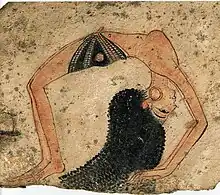 Ancient Egyptian dancer, c. 1200 BC
Ancient Egyptian dancer, c. 1200 BC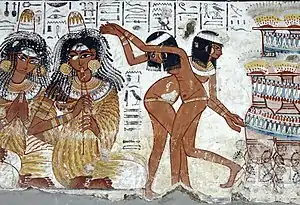 Tomb of Nebamun c. 1400 BC
Tomb of Nebamun c. 1400 BC
Dance in classical Crete and Greece seems to have been influenced by the dances of Ancient Egypt.[6] There are many examples of ancient Greek art from the 6th and 5th centuries BC depicting dancing women.[5] The virgins of Delos danced in a circle to honour Apollo[7] while Terpsichore was the Muse of dance.[8] In the 6th century BC, the choros became a lasting feature of Greek theatre while women known as the Dyonysiac, frequently depicted on Greek vases, dance in frensy, celebrating Dionysus, the god of wine.[9] In Ancient Rome, female singers and dancers performed in the annual celebrations of Isis which included mystery plays representing the resurrection of Osiris.[10]
 Musician and dancer, Athens, 460 BC
Musician and dancer, Athens, 460 BC Greek dancing girl, 5th century BC
Greek dancing girl, 5th century BC Greek terracotta statuette of a dancing Maenad, 3rd century BC
Greek terracotta statuette of a dancing Maenad, 3rd century BC Veiled dancer, terracotta, c. 100 BC
Veiled dancer, terracotta, c. 100 BC Fresco of Dionysic initiation dance, Pompei, c. 60 BC
Fresco of Dionysic initiation dance, Pompei, c. 60 BC
The Bible contains several accounts of women dancing, in particular the celebrations led by Miriam after the crossing of the Red Sea when women are said to have danced and played hand-drums.[11] After David had returned from slaying Goliath, women came out singing and dancing.[12] In the New Testament, Matthew tells the story of how Salome danced for Herod in order to be given the head of John the Baptist.[13]
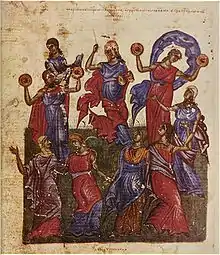 Miriam's dance, Tomić Psalter, c. 1360
Miriam's dance, Tomić Psalter, c. 1360 Dance of Salome, Robert Fowler (1885)
Dance of Salome, Robert Fowler (1885)
China and Japan
In China too there is a long recorded history of women dancers since the Zhou dynasty (c. 1046–256 BC) reaching a peak in the Tang dynasty (618–907 AD).[14] The chorus dances performed by women in the Zhou dynasty were known as xi. The ancient theatrical spectacles called baixi probably involved dancing girls in dresses with fluttering silk sleeves.[15] Texts from the Spring and Autumn period (771–476 BC) contain descriptions of professional dancing girls while the Nishang Yuyi dance, created by the Emperor Li Longji (685–762), stages virgin women dancing as if in a magic world.[16] In the early 1900s, modern dance was first introduced to China by Nellie Yu Roung Ling, daughter of a Qing-dynasty diplomat to France.[17] She developed a series of dance styles combining Eastern aesthetic with Western technique during her time in the Qing imperial court.[18] In 12th-century Japan, the Shirabyoshi were famous for their dancing and poetry. One of the most famous was the court dancer Shizuka who appears in the Japanese literature of the period.[19]
 Chinese dancer from the Tang dynasty
Chinese dancer from the Tang dynasty Statuettes of female musicians and a dancer, Sui dynasty (c. 600 AD)
Statuettes of female musicians and a dancer, Sui dynasty (c. 600 AD) Dancing figures, Tang dynasty, 7th century
Dancing figures, Tang dynasty, 7th century Female dancer from the Tang dynasty
Female dancer from the Tang dynasty Female dancer, Han dynasty
Female dancer, Han dynasty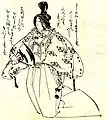 Shizuka from 12th-century Japan
Shizuka from 12th-century Japan
India
India has nine classical dances. Some are performed exclusively by women such as Mohiniattam. Others are performed with men, such as Kathak.
Middle Ages in Europe
In the Middle Ages, with the spread of Christianity across Europe, the church generally frowned upon dance although there was often dancing at folk festivals, particularly at the beginning of May. In France and Italy, chain and circular dances such as the carole, and the tresque were popular from the 4th to 14th centuries.[20] They were usually danced in a closed circle with men and women interspersed and holding hands.[21] In Italy, the lively saltarello from Naples became popular in the 14th and 15th centuries. Groups of courtesans dressed as men performed the dance at masquerades.[22]
 Dancing the carole (Roman de la Rose, c. 1250)
Dancing the carole (Roman de la Rose, c. 1250) Medieval dance
Medieval dance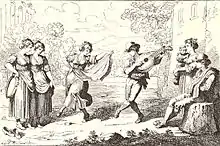 Saltarello, illustrated by Bartolomeo Pinelli
Saltarello, illustrated by Bartolomeo Pinelli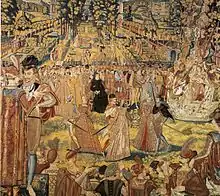 Lavish ball held by Catherine de' Medici in 1573
Lavish ball held by Catherine de' Medici in 1573
Emergence of ballet
In the 15th century, court festivities in Italy became ever more elaborate, often featuring formal dances. One of the early masters was Domenico da Piacenza (c. 1400–1470) who compiled a manual of dance: De arte saltandi et choreas ducendi.[23] In France, too, professional dancing began to take shape when dancers performed for Henry III of France at Fontainebleau in the early 1580s. Further presentations were made for Louis XIII, who frequently took the main part himself. But it was, above all, during the reign of Louis XIV (1643–1715) that the foundations were laid for what became known as ballet. The king not only had the rules of dance written down but established the Académie Royale de Danse in 1661, which developed into today's Paris Opera Ballet.[5] Many of the early ballets were created by the Italian-French composer Jean Baptiste Lully and the French choreographer Pierre Beauchamp, often assisted by Molière.[24]
Initially, female parts in the early ballets were taken by young men; but, in 1681, a young woman known as Mademoiselle De Lafontaine danced in Lully's Le Triomphe de l'amour.[25] She went on to be the leading ballerina in at least 18 other productions at the Paris Opera between 1681 and 1693, establishing the supreme importance of women in ballet.[26] De Lafontaine was succeeded by Marie-Thérèse de Subligny who became the first ballerina to perform in London when she appeared with Claude Ballon in 1699.[27] Said to be the best ballerina of her day, with beautiful eyes and a fine figure, Subligny danced at the Paris Opera from 1688 until her retirement in 1707.[28]
The next leading dancer of the Opéra was Françoise Prévost (1680–1741), whose precision, lightness and grace contributed much to classical ballet.[29] She persuaded conductor Jean-Féry Rebel to compose suites specifically for ballet. His Caprice, Boutade, Les Caractères de la danse and La Terpsichore brought her considerable success. In particular, her personal interpretation of the steps in Caprice served as an example for other soloists while she transformed the Caractères into a sequence illustrating different types of lover, both male and female. Prévost trained two highly successful dancers, Marie Camargo (1710–1770) and Marie Sallé (1707–1756), who added their personal preferences to her Caractères, each developing individual styles. They would take her place as prima ballerinas after she retired from the opera in 1730.[30][31]
Camargo proved to be a tremendous success, not only as a result of her dazzling footwork (especially her entrechat à quatre), but because she introduced slightly shorter skirts and new hair styles.[32] She also discarded high-heeled shoes, introducing dancing slippers which facilitated the execution of the more demanding routines.[33] By dancing demanding routines, which had previously been performed exclusively by men, Camargo further consolidated the image of the ballerina.[34]
Sallé sought more from ballet than skillful demonstrations of technique as favoured by proponents of traditional ballet. She believed music, steps, decor and costumes should all contribute to a graceful, expressive performance combining pantomime with dance in what became known as ballet d'action. As many in the Paris Opera did not share her views, she decided to move to the more liberal London. At Covent Garden, she caused a sensation in 1734 as Galatea in Pygmalion, a ballet she had choreographed herself. Discarding the usual attire of a ballerina, she chose to wear a simple muslin tunic and allow her hair to fall freely over her shoulders.[35] The following year, she even decided to dress as a man while performing the role of Cupid but the reviews were extremely critical. As a result, she returned to Paris where she danced at the Opéra until her retirement in 1740 at the young age of 33. Thereafter, she occasionally danced for the court at Versailles.[30]
During the second half of the 18th century, the dominating star of the Paris Opera was Marie-Madeleine Guimard who may not have had the technique of Sallé but was nevertheless recognized for her sensuous movements, her numerous suitors and her exotic attire. Other stars included Marie Allard (1738–1802) who joined the Paris Opera in 1756 where she was trained by Gaétan Vestris, becoming not just an étoile but also his wife. Although she was rather corpulent and frequently pregnant, she was acclaimed for her impressive footwork.[36]
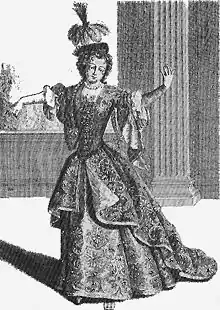 Marie-Thérèse de Subligny (c. 1700)
Marie-Thérèse de Subligny (c. 1700) Françoise Prévost (c. 1723)
Françoise Prévost (c. 1723) Marie Camargo painted by Nicolas Lancret (c. 1730)
Marie Camargo painted by Nicolas Lancret (c. 1730) Marie Sallé (c. 1730)
Marie Sallé (c. 1730) Marie-Madeleine Guimard (c. 1774)
Marie-Madeleine Guimard (c. 1774)
Romantic ballet
The most successful period for female ballet dancers was around the 1830s and 1840s when they became the great stars of Romantic ballet. The Italian-Swedish Marie Taglioni (1804–1884) not only excelled at the Paris Opera when she danced La Sylphide in 1832 but extended her fame to Saint Petersburg's Mariinsky Ballet as well as to the stages of Berlin, Milan and London until her retirement in 1847. It was she who developed ballet's en pointe (dancing on the tips of the toes) while introducing new fashions in dress and hair styling which became popular throughout Europe. The Austrian Fanny Elssler (1810–1884) gained fame and fortune by dancing the flirtatious Spanish cachucha in Le Diable boiteux, performing not only in Austria, Germany, France, England and Russia but also in the United States. Nevertheless, in 1845 she refused to dance with her rivals Marie Taglioni, Carlotta Grisi, Fanny Cerrito, and Lucile Grahn in Jules Perrot's Pas de Quatre.[37][38]
Presented at Her Majesty's Theatre in London, the Pas de Quatre caused a sensation, bringing together the four greatest ballerinas of the day. In addition to Marie Taglioni, Italy's Grisi (1819–1899) had become famous both in Paris and Saint Petersburg for her Giselle, while Cerrito from Naples had become the star of La Scala in Milan. Grahn (1819–1907), a Dane trained by Bournonville, was based in Paris but had also danced in London, Saint Petersburg and Milan before settling in Germany.[37]
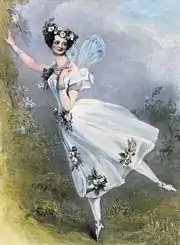 Marie Taglioni in Zephire et Flore (c. 1831)
Marie Taglioni in Zephire et Flore (c. 1831)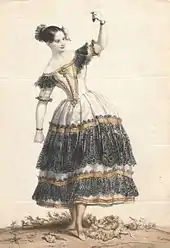 Fanny Elssler in La Cachucha (1836)
Fanny Elssler in La Cachucha (1836) Carlotta Grisi in Giselle (1841)
Carlotta Grisi in Giselle (1841) Fanny Cerrito in La Vivandière (1844)
Fanny Cerrito in La Vivandière (1844) Lucile Grahn in La Cachucha (1838)
Lucile Grahn in La Cachucha (1838) Pauline Leroux in Le Diable Amoureux (1840)
Pauline Leroux in Le Diable Amoureux (1840)
Several notable Italian ballerinas emerged in the second half of the 19th century, reaching their zeniths in Russia. Italian-born Virginia Zucchi (1849–1933) first danced in Italy and Germany but her interpretations of Marius Petipa's ballet in Russia were so successful that the Tzar insisted she should join the Mariinsky Ballet in Saint Petersburg. In the mid-1880s, she starred in Coppélia, La fille mal gardée and La Esmeralda, revolutionizing ballet in Russia through the extraordinary power of her performances.[39] Pierina Legnani (1863–1930) from Milan followed as similar path, also dancing at the Mariinsky from 1892 where she originated famous roles in Petipa's ballets including Cinderella, Swan Lake and Raymonda, gaining the title of prima ballerina assoluta.[40] Carlotta Brianza (1865–1938), also from Milan, first gained fame at La Scala with which she toured the United States. She is remembered above all for dancing Aurora at the premiere of Petipa's Sleeping Beauty in 1890.[41][42]
 Virginia Zucchi in La Esmeralda (1886)
Virginia Zucchi in La Esmeralda (1886) Pierina Legnani in La Perle (1896)
Pierina Legnani in La Perle (1896) Carlotta Brianza in La Esmeralda (c. 1890)
Carlotta Brianza in La Esmeralda (c. 1890)
20th-century ballet
New, more dynamic approaches to ballet developed from the beginning of the 20th century, the most influential being Sergei Diaghilev's Ballets Russes, promoting innovative collaborations between choreographers, composers and dancers.[43] One of the early stars was Anna Pavlova (1881–1931) who gained fame by dancing The Dying Swan choreographed by Mikhail Fokine before joining the Ballets Russes in 1909.[44] Her rival, Tamara Karsavina (1885–1978), who also performed with the Ballets Russes, is remembered above all for creating the title role in Fokine's The Firebird.[45] Olga Spessivtseva (1895–1991) danced with the Mariinsky in Saint Petersburg but also toured with the Ballets Russes, dancing Aurora in Diaghilev's The Sleeping Princess (1921) in London.[46]
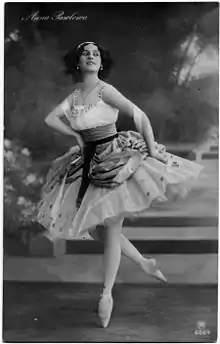 Anna Pavlova (1912)
Anna Pavlova (1912) Tamara Karsavina (1911)
Tamara Karsavina (1911) Olga Spessivtseva (1934)
Olga Spessivtseva (1934)
Ballet also began to develop in London, thanks mainly to the efforts of two women. Polish-born Marie Rambert (1888–1982) who had also gained experience with the Ballets Russes founded the Ballet Club (later the Rambert Dance Company) in 1926 introducing new choreographers such as Frederick Ashton. Even more influential, Ninette de Valois (1898–2001) spent three years with the Ballets Russes before creating London's Vic-Wells Ballet in 1931 (later becoming the Royal Ballet) where Alicia Markova (1910–2004) was the first prima ballerina, starring in ballets from the Mariinsky's classical productions. Markova left to form her own touring company in 1937. Ten years later Margot Fonteyn (1919–1991) became the company's prima ballerina.[47] The height of her fame came in 1961 when she embarked on a partnership with Rudolf Nureyev, first in Giselle, until she retired in 1979.[48]
 Marie Rambert, centre (1943)
Marie Rambert, centre (1943)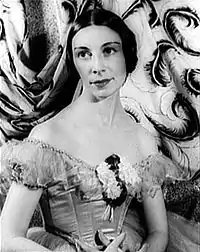 Alicia Markova (1940)
Alicia Markova (1940)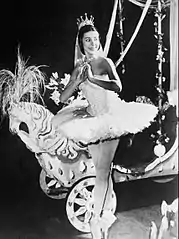 Margot Fonteyn (1957)
Margot Fonteyn (1957)
As ballet developed in the United States, Maria Tallchief (1925–2013), the first major American prima ballerina, was promoted by the choreographer Bronislava Nijinska (1891–1972) when she joined the Ballet Russe de Monte Carlo in New York in 1942. She danced as a soloist in George Balanchine's arrangements for Song of Norway in 1944. As Balanchine's wife, she soon became the star of the New York City Ballet.[49] Lucia Chase (1897–1986) was a co-founder of the American Ballet Theatre in 1939 and became its artistic director for over 40 years, overseeing the production of a wide variety of new ballets.[50] Several outstanding American ballerinas have emerged over the years including Gelsey Kirkland (born 1952), who performed the leading role in The Firebird when she was just 17,[51] and Suzanne Farrell (born 1945) who was the star of Balanchine's Don Quixote in 1965.[52]
 Ballet Russe de Monte Carlo, Nutcracker (1940)
Ballet Russe de Monte Carlo, Nutcracker (1940) Maria Tallchief (1954)
Maria Tallchief (1954) Suzanne Farrell (1965)
Suzanne Farrell (1965)
Other forms of dance

Women have also contributed significantly to most other forms of dance, in particular flamenco, modern dance, expressionist dance, belly dance and cabaret which led to musical theatre.[53]
Flamenco
Flamenco music originated in the south of Spain in the 15th century, probably resulting from the influence of the Moors with possible origins in India. While many of the singers who emerged in the 18th century were men, women increasingly gained fame as dancers.[54] One of the earliest was Juana la Macarrona (1860–1947) who first performed in Seville with singer Silverio Franconetti but soon become popular not only throughout Spain but across Europe.[55] Lola Flores (1923–1995) is remembered for singing and dancing Andalusian folklore, especially flamenco, copla and chotis.[56] Angelita Vargas (born 1946) is considered to be one of the greatest stars of Andalusian flamenco dancing, touring Europe, the United States, Japan and Australia.[57]
Modern dance in the United States
Led by women, various styles of modern dance began to develop towards the end of the 19th century. Loie Fuller (1862–1928) from Chicago was one of the pioneers. She employed her own natural approach to movement and improvisation, later becoming a star at the Folies Bergères in Paris.[58] Inspired by Greek art, Isadora Duncan (1877–1927) from San Francisco paved the way to the modern free dance style believing it was more important to express the essence of life through movement rather than to follow the precepts of classical ballet.[59] Raised on a farm in New Jersey, Ruth St. Denis (1879–1968) developed her own interpretations of Oriental dance as an expression of spiritualism.[60] The American Martha Graham (1894–1991) exerted considerable influence on the development of modern dance through her New York-based Martha Graham Center of Contemporary Dance.[61] Other female figures who contributed to developments in the mid-20th century include Doris Humphrey (1895–1958) who choreographed Afro-American spirituals and Helen Tamiris (1905–1966) who played an important part in choreographing early musicals.[62][63] Another major choreographer of Broadway musicals was German-born Hanya Holm (1893–1992), a student of Mary Wigman.[64]
 Loie Fuller (1896)
Loie Fuller (1896)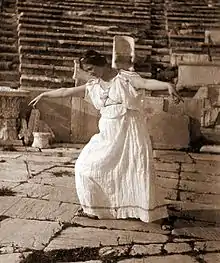 Isadora Duncan (1903)
Isadora Duncan (1903).jpg.webp) Ruth St. Denis (1916)
Ruth St. Denis (1916)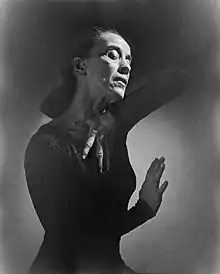 Martha Graham (1948)
Martha Graham (1948)
Expressionist dance
The German Mary Wigman is credited as the creator of expressionist dance. Inspired by Oriental percussion, she often stressed the macabre.[65] Hertha Feist (1896–1990), also from Germany, was an expressionist dancer and choreographer. She established her own school in Berlin, combining gymnastics with nudism and dance although her ambitions were later seriously curtailed by the Nazis.[66] Also an associate of Wigman, Gret Palucca (1902–1993) opened her own schools in Germany in the 1920s and 1930s but they were later closed because of her Jewish ancestry.[67] One of her students, Dore Hoyer (1911–1967), who was also an associate of Mary Wigman, developed her own programmes before the Second World War in Germany, the Netherlands, Denmark and Sweden. After the war she became ballet director at the Hamburg State Opera.[68]
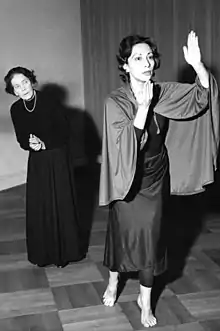 Mary Wigman (1959)
Mary Wigman (1959) Gret Palucca (1930s)
Gret Palucca (1930s)
Belly dance
While belly dancing appears to have its origins in the distant past, it was introduced to Europe and North America towards the end of the 19th century. Several of Egypt's film actresses performed belly dancing in the musicals of the 1930s and 1940s.[69] Early stars included Tahia Carioca (1919–1999), Samia Gamal (1924–1994) and Nelly Mazloum (1929–2003).[70] From the 1960s, belly dance became increasingly popular across the United States with stars including Dalilah (1936–2001), Dahlena and Serena (1933–2007).[71]
 Egyptian belly dancer, Chicago World Fair (1893)
Egyptian belly dancer, Chicago World Fair (1893)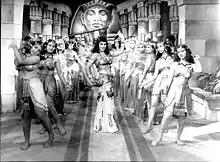 Tahia Carioca (1920)
Tahia Carioca (1920) Dalilah (1963)
Dalilah (1963) Randa Kamel, Cairo (2007)
Randa Kamel, Cairo (2007)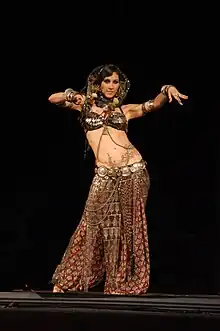 Rachel Brice, Rennes (2012)
Rachel Brice, Rennes (2012)
Cabaret
Women started to sing and dance in the cabarets of Paris in the 1890s, emphasizing the female body by introducing seductive movements highlighting their breasts and hips. Most of them had no formal training, the exception being Cléo de Mérode (1875–1966) who left the Paris Opera to perform at the Folies Bergère.[72] The major choreographer was Algerian-born Mariquita (1830–1922) who became ballet director at the Folies Bergère and the Opéra Comique. Stars of the period included the Spanish La Belle Otero from Galicia who gained fame at Charles Franconi's Cirque d'été in 1890,[73] Émilienne d’Alençon (1869–1946) who danced at the Folies Bergère, and Dutch-born Mata Hari (1876–1917) who from 1905 became famous for her Indonesian-inspired temple dance, first in Paris and then in other European capitals.[72][74] La Goulue (1866–1929) is remembered for dancing the cancan at the Moulin Rouge in the 1890s.[75]
 Marquita and Émilienne d’Alençon (1893)
Marquita and Émilienne d’Alençon (1893) Cléo de Mérode (c. 1897)
Cléo de Mérode (c. 1897) La Belle Otero (c. 1905)
La Belle Otero (c. 1905) Mata Hari (1906)
Mata Hari (1906)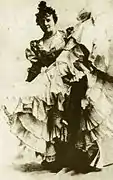 La Goulue (c. 1890)
La Goulue (c. 1890)
African American Dance
Before World War II racism influenced dance in a drastic way. During this time they had social dances, such as the swing, jitterbug, and Lindy Hop, that black people created to please rich white people. Dance was therapy or a drug because during the Great Depression it was a way for them to find happiness, dancing brought races together, and even just watching it made people feel better about what they were already going through. After WWII, dance was transformed into something that everyone could easily learn how to do even if they were just starting. It was becoming more of a street social dance that everyone could enjoy and even though there was still racism but in different ways, dance was a way to enjoy life and was a new way to entertain. Other dances like the Charleston, Pattin' Juba, Jive, Spank the baby, and Boogie Back became major dance staples for the black community and many other communities of dance and social dance. These dance styles set the foundations of present-day jazz technique.
See also
References
- ↑ "Egyptia Dance and Music". Kibbutz Reshafim. Retrieved 4 April 2014.
- ↑ Patricia Spencer. "Female Dance in Ancient Egypt" (PDF). The Raqs Shardi Society. Retrieved 4 April 2014.
- ↑ "Pre-History & Archaeology". National Museum, Janpath, New Delhi. Archived from the original on 6 January 2019. Retrieved 4 April 2014.
- ↑ Elisabeth Gouet. "Les grands courants de la danse" (PDF) (in French). Académie de Bordeaux. Retrieved 2 April 2014.
- 1 2 3 Michel Landry. "La Danse au fil des âges" (in French). CÉGEP du Vieux Montréal. Retrieved 2 April 2014.
- ↑ "Dance in classical Greece". Encyclopædia Britannica. Retrieved 6 April 2014.
- ↑ Calame, Claude (1 January 2001). Choruses of Young Women in Ancient Greece: Their Morphology, Religious Role, and Social Functions. Rowman & Littlefield. pp. 35–. ISBN 978-0-7425-1525-3.
- ↑ "Terpsichire". Encyclopædia Britannica. Retrieved 6 April 2014.
- ↑ "History of Dance: Dance and Music". History World. Retrieved 4 April 2014.
- ↑ Edward I. Bleiberg, ed. (2005). "Women in Ancient Music: Arts and Humanities Through the Eras". Gale: Student Resources in Context. Retrieved 6 April 2014.
- ↑ Carol Meyers. "Women with hand-drums, dancing: Bible". Jewish Women's Archive. Retrieved 4 April 2014.
- ↑ "1 Samuel 18:6". Bible Hub. Retrieved 8 April 2014.
- ↑ "John the Baptist Beheaded, Matthew 14-14". Bible Gateway. Retrieved 6 April 2014.
- ↑ Zehou Li (2009). The Chinese Aesthetic Tradition. translated by Maija Bell Samei. University of Hawaii Press. p. 5. ISBN 978-0824833077.
- ↑ The Early History of Chinese Theatre. Theatre Academy Helsinki. ISBN 978-952-9765-56-0. Archived from the original on 21 October 2017. Retrieved 6 April 2014.
- ↑ Yaron Margolin. "Dance History of China". Israel Dance. Retrieved 6 April 2014.
- ↑ Witchard, Anne (15 October 2019). "Dancing Modern China". modernismmodernity.org. Retrieved 20 February 2022.
- ↑ Xiao, Huang (27 December 2021). "Alle origini della screendance in Cina: Visioni (Xiang 象) in trasformazione e forme (Xing 形) artistiche". Danza e Ricerca: Laboratorio di Studi, Scritture, Visioni (in Italian) (13). doi:10.6092/issn.2036-1599/14130. Retrieved 20 February 2022.
- ↑ "History of the Geisha, Part One: 1100AD - 1750AD". Immortal Geisha. Retrieved 9 April 2014.
- ↑ "Danses médiévales et renaissance" (in French). La Marotte. Retrieved 6 April 2014.
- ↑ Mullally, Robert (2011). The Carole: A Study of a Medieval Dance. Farnham, Surrey, England: Ashgate. pp. 41–50. ISBN 978-1-4094-1248-9.
- ↑ Caroso, Fabritio (1995). Courtly Dance of the Renaissance: A New Translation and Edition of the Nobiltà Di Dame (1600). Courier Dover Publications. pp. 43–. ISBN 978-0-486-28619-8.
- ↑ "De arte saltandi et choreas ducendi". pbm.com. Retrieved 8 April 2014.
- ↑ "History of Ballet". Northeastern University. Retrieved 8 April 2014.
- ↑ "La Fontaine". Encyclopædia Britannica. Retrieved 9 April 2014.
- ↑ "Mlle de Lafontaine". Oxford Reference. Retrieved 9 April 2014.
- ↑ "Marie-Thérèse Subligny". Oxford Reference. Retrieved 9 April 2014.
- ↑ "Le Triomphe de l'amour" (in French). Le magazine de l'opéra baroque. Archived from the original on 1 March 2014. Retrieved 9 April 2014.
- ↑ "Françoise Prévost". Encyclopædia Britannica. Retrieved 9 April 2014.
- 1 2 Brooks, Lynn (2007). Women's Work: Making Dance in Europe Before 1800. Univ of Wisconsin Press. pp. 131–. ISBN 978-0-299-22530-8.
- ↑ Greskovic, Robert (2005). Ballet 101: A Complete Guide to Learning and Loving the Ballet. Hal Leonard Corporation. pp. 19–. ISBN 978-0-87910-325-5.
- ↑ "Marie Camargo". Encyclopædia Britannica. Retrieved 9 April 2014.
- ↑ Kassing, Gayle (2007). History of Dance: An Interactive Arts Approach. Human Kinetics. pp. 113–. ISBN 978-0-7360-6035-6.
- ↑ "La Danseuse : Evolution et Révolution: Les années 1700 à 1750: Les premières danseuses à l'Opéra" (in French). Mount Holyoke. Retrieved 10 April 2014.
- ↑ Garfunkel, Trudy (2002). On Wings of Joy. E-reads/E-rights. pp. 20–. ISBN 978-0-7592-2862-7.
- ↑ "La Danseuse: Evolution et Révolution: Les années 1750 à 1830" (in French). Mount Holyoke. Retrieved 11 April 2014.
- 1 2 "Romantic Ballet". Victoria and Albert Museum. Retrieved 16 April 2014.
- ↑ "La Danseuse: Evolution et Révolution: Les années 1830 à 1848:La danse romantique" (in French). Mount Holyoke. Retrieved 16 April 2014.
- ↑ "Virginia Zucchi". Oxford Index. Retrieved 17 April 2014.
- ↑ "Pierina Legnani". Oxford Reference. Retrieved 17 April 2014.
- ↑ "Carlotta Brianza". Oxford Index. Retrieved 17 April 2014.
- ↑ Praagh, Peggy Van; Brinson, Peter (1963). The choreographic art: an outline of its principles and craft. Knopf.
- ↑ Kirstie Brewer (13 October 2010). "Diaghilev's Golden Age of the Ballets Russes dazzles London with V&A display". Culture24. Retrieved 23 April 2014.
- ↑ "The Legendary Anna Pavlova". Russian Ballet History. Retrieved 23 April 2014.
- ↑ "Diaghilev's dancers". Russian Ballet History. Retrieved 23 April 2014.
- ↑ "Olga Spessivtseva" (in French). Les étoiles de l'Opéra de Paris. Retrieved 23 April 2014.
- ↑ "The Establishment of British Ballet". V&A. Retrieved 23 April 2014.
- ↑ "Rudolf Nureyev and Margot Fonteyn, the perfect partnership". Rudolf Nureyev Foundation. Retrieved 23 April 2014.
- ↑ Jack Anderson (12 April 2013). "Maria Tallchief, a Dazzling Ballerina and Muse for Balanchine, Dies at 88". New York Times. Retrieved 24 April 2014.
- ↑ Anna Kisselgoff (19 January 1986). "Dance View: Lucia Chase Helped Create the Ballet World we Know". New York Times. Retrieved 24 April 2014.
- ↑ "Gelsey Kirkland". Biography.com. Retrieved 24 April 2014.
- ↑ "Suzanne Farrell Biography". Academy of Achievement. Retrieved 24 April 2014.
- ↑ "Dance Forms: An Introduction". ArtsAlive.ca. Retrieved 17 April 2014.
- ↑ "Flamenco: Evolución. Etapa Hermética. Primeros cantaores" (in Spanish). Andalucía.org. Retrieved 18 April 2014.
- ↑ "La Macarrona" (in Spanish). Noticias y Ocio. Retrieved 18 April 2014.
- ↑ "Lola Flores". Andalucia.com. Retrieved 18 April 2014.
- ↑ "Angelita Vargas" (in French). Apsâra Flamenco. Retrieved 18 April 2014.
- ↑ "Loie Fuller". Dance: National Arts Centre. Retrieved 18 April 2014.
- ↑ "The Beginnings of Modern Dance". Miami Dade College. Retrieved 18 April 2014.
- ↑ "Ruth St. Denis (1879—1968): America's Divine Dancer" (PDF). Dance Heritage Coalition. Retrieved 18 April 2014.
- ↑ "Martha Graham". Oxford Reference. Retrieved 20 April 2014.
- ↑ Henderson, Lol; Stacey, Lee (2014). Encyclopedia of Music in the 20th Century. Routledge. pp. 41–. ISBN 978-1-135-92946-6.
- ↑ Pauline Tish. "Helen Tamaris". Jewish Women's Archive. Retrieved 20 April 2014.
- ↑ Jennifer Dunning (4 November 1992). "Hanya Holm Is Dead at 99; Influential Choreographer". New York Times. Retrieved 20 April 2014.
- ↑ "Expressionistic Dance: Mary Wigman". Twentieth Century Dance. Retrieved 18 April 2014.
- ↑ Frank-Manuel Peter. "Feist" (in German). SK Stiftung Kultur. Retrieved 19 February 2014.
- ↑ "Gret Palucca" (in German). Akademie der Künste. Retrieved 19 April 2014.
- ↑ "Dore Hoyer (1911-1967)" (in German). SK Stiftung Kultur. Retrieved 19 April 2014.
- ↑ "Bellydance Unveiled: A Brief History". Aleenah.com. Retrieved 20 April 2014.
- ↑ Hammond, Andrew (2007). Popular Culture in the Arab World: Arts, Politics, and the Media. American Univ in Cairo Press. pp. 192–. ISBN 978-977-416-054-7.
- ↑ Helen Waldie. "Belly Dance History ~ An American Odessey: A History of Modern US Bellydance". IAMED. Retrieved 20 April 2014.
- 1 2 "La Danseuse: Evolution et Révolution: Les années 1890 à 1914: La Belle Epoque". Mount Holyoke. Retrieved 21 April 2014.
- ↑ "La Belle Otero, emblème de la Belle Époque" (in French). Histoire par l'image. Retrieved 21 April 2014.
- ↑ "Mata Hari: Spy, Dancer (1876–1917)". bio. Retrieved 22 April 2014.
- ↑ "Weber Louise, dit La Goulue (1866-1929)" (in French). Amis et Passionnés du Père-Lachaise. Archived from the original on 12 August 2014. Retrieved 22 April 2014.
Literature
- Brooks, Lynn (2007). Women's Work: Making Dance in Europe Before 1800. Univ of Wisconsin Press. ISBN 978-0-299-22530-8.
- Calame, Claude (2001). Choruses of Young Women in Ancient Greece: Their Morphology, Religious Role, and Social Functions. Rowman & Littlefield. ISBN 978-0-7425-1525-3.
- Drinker, Sophie (1995). Music and Women: The Story of Women in Their Relation to Music. Feminist Press at CUNY. ISBN 978-1-55861-116-0.
- Guest, Ivor (1976). Le Ballet de l'Opéra de Paris: trois siècles d'histoire et de tradition. Théâtre national de l'Opéra.
- Lexová, Irena (2012). Ancient Egyptian Dances. Courier Dover Publications. ISBN 978-0-486-14870-0.
- Varadpande, Manohar Laxman (2006). Woman in Indian Sculpture. Abhinav Publications. ISBN 978-81-7017-474-5.

